There were a lot of happy, smiling faces in Kaohsiung on Saturday last week as the Weiwuying National Kaohsiung Center for the Arts formally opened, but the biggest smiles were on the faces of the center’s artistic director, conductor Chien Wen-pin (簡文彬), and its Dutch architect, Francine Houben, founding partner of Delft-based firm Mecanoo.
They smiled through the obligatory pre-opening talks and photographs with journalists, they smiled through the opening ceremony, with speeches by President Tsai Ing-wen (蔡英文), Presidential Office Secretary-General Chen Chu (陳菊) — who as the former mayor of Kaohsiung presided over a substantial portion of the center’s construction — and Houben herself, while Chien conducted a combined orchestra through three short works by Taiwanese composers.
However, they were not the only ones looking very pleased. Dignitaries ranging from the Minister of Culture Cheng Li-chiun (鄭麗君) and Cloud Gate Dance Theatre (雲門舞集) artistic director Lin Hwai-min (林懷民) to representatives of all the firms involved in the construction and stage and lighting designer Lin Keh-hua (林克華), as well as many Taiwanese performers and theater folk, as well as thousands and thousands of Kaohsiung residents who bought tickets for the opening concert or packed the parkland to the south of the structure to watch the Arts for the People show performed on the center’s outdoor theater where its roof dips down to touch the ground.
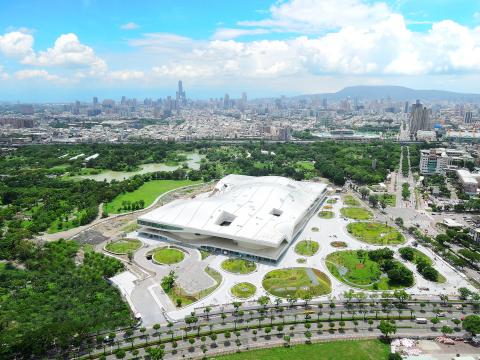
Photo: CNA
People enjoyed themselves so much on Saturday that many stayed after the final show posing for photos and exploring open venues.
The Weiwuying area was a military base during the Japanese colonial era and then became a base for the Eighth Army Group, serving as a training center for thousands of conscripts over the decades. In the post-Martial Law era, the military decided it no longer needed the base and a 20-year-battle to preserve at least a portion of the massive site as a city park began.
The Kaohsiung City Government opened an international architectural competition in 2006 to design a performance center, which Houbin’s team won the following year, while the 47 hectare Weiwuying Metropolitan Park was finally established in 2010.
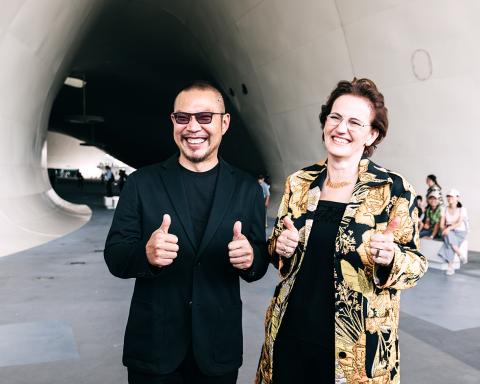
Photo courtesy of Weiwuying National Kaohsiung Center for the Arts
Completing the art center would take much longer, buffeted as it was by construction delays and other problems. However, one benefit of the years of delays is that it gave the city time to expand its Mass Rapid Transit system out to Weiwuying and beyond, with exits right outside the center, making it more convenient and easier for people to reach.
The design by Houben and her Mecanoo team encompasses 3.3 hectares, with five performances spaces linked by the air and light-filled Banyan Plaza walkway, and is the largest performing arts center under one roof in the world.
More importantly, at least for Kaohsiung’s residents, is Houben’s undulating design that links the banyan tree-filled park outside the center with the city’s history as a maritime port and its shipbuilding industry, while the Banyan Plaza channels the breezes off the ocean and its 14 futuristic chandeliers emphasize her vision of the plaza as a living room for the city.
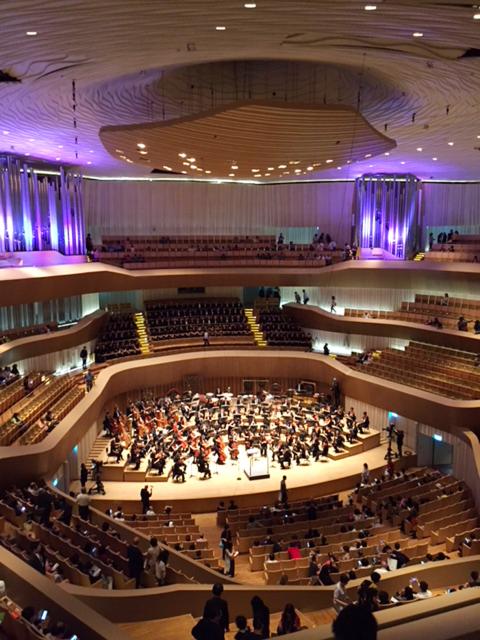
Photo: Diane Baker, Taipei Times
She said she was inspired by her first visit to the city 12 years ago by the children and adults she saw in the future park area, playing and relaxing under the banyan trees. She had also been impressed by the numbers of young people and adults using the spaces outside the Sun Yat-sen Memorial Hall and the National Theater Concert Hall (NTCH) in Taipei to practice taichi and dancing.
Houben said her philosophy is that architecture should touch all five senses, and she certainly has achieved that with Weiwuying, which is likely to become one of her most iconic projects, and the flagship cultural destination she said she aimed to deliver.
From the building’s aluminum skin created by Kaohsiung shipbuilders, to the vineyard design of the 2,000 seat Concert Hall, with its massive 9,085 pipe organ, divided like two stands of bamboo, to the rolling waves of the walkways and fabric designs and ceilings, the center invites people to explore and enjoy.
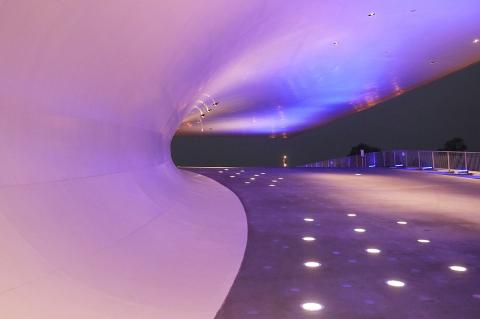
Photo: CNA
In addition to the Concert Hall, there is a 2,260 seat Opera House, a Playhouse that can seat between 1,094 and 1,254 people, a 470 seat Recital Hall and an outdoor performance space facing the park, which means up to 20,000 people could see a show there at one time.
There are also several places to eat and shop, including Milieu Tea House, Perfume Dance restaurant, Stage5 Bistro and the X Simtree Cafe.
Weiwuying is now the third branch of the National Performing Arts Center, after the NTCH and the National Taichung Theater.
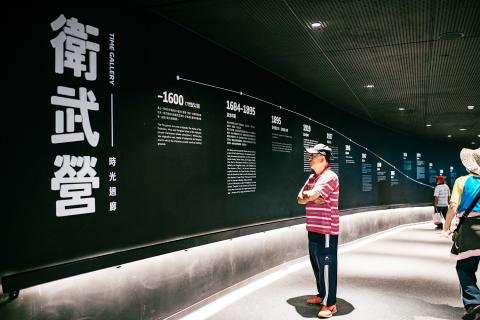
Photo courtesy of Weiwuying National Kaohsiung Center for the Arts
For its opening season, which runs through the end of this year, the center has put together a program of theater, dance, music and circus arts that features more than 70 performances and 171 artists and groups from around Taiwan and the world.
They had their first sold-out show on Sunday, with a concert by Latvian organist Iveta Apkalna, with the tickets selling within a few days. She played the organ during the official opening ceremony on Saturday and the sound produced by the massive pipes was stirring.
Highlights of the next two-and-a-half months include the Berlin Philharmonic Orchestra, Mariss Jansons & Symphonieorchester des Bayerischen Rundfunks, La Fura Dels Baus production The Creation, Leonard Bernstein’s operetta Candide, two Taiwanese and Kunqu opera productions, Cloud Gate Dance Theatre’s 45th Anniversary Gala Program, SMAP X SMAP by Shakespeare’s Wild Sisters Group (莎士比亞的妹妹們的劇團), Robert Lepage’s 887, MUMMENSCHANZ’s You & Me and Paradise Interrupted, Weiwuying’s first international co-commissioned opera with Lincoln Center Festival, Spoleto Festival USA and Singapore International Festival of Arts..
The Weiwuying Opening Season offers a special ticket combo of 20 percent off purchases of NT$500 and above with at least one show per month from now until December; however the offer is only available until Oct. 31.

Jan. 5 to Jan. 11 Of the more than 3,000km of sugar railway that once criss-crossed central and southern Taiwan, just 16.1km remain in operation today. By the time Dafydd Fell began photographing the network in earnest in 1994, it was already well past its heyday. The system had been significantly cut back, leaving behind abandoned stations, rusting rolling stock and crumbling facilities. This reduction continued during the five years of his documentation, adding urgency to his task. As passenger services had already ceased by then, Fell had to wait for the sugarcane harvest season each year, which typically ran from

It’s a good thing that 2025 is over. Yes, I fully expect we will look back on the year with nostalgia, once we have experienced this year and 2027. Traditionally at New Years much discourse is devoted to discussing what happened the previous year. Let’s have a look at what didn’t happen. Many bad things did not happen. The People’s Republic of China (PRC) did not attack Taiwan. We didn’t have a massive, destructive earthquake or drought. We didn’t have a major human pandemic. No widespread unemployment or other destructive social events. Nothing serious was done about Taiwan’s swelling birth rate catastrophe.
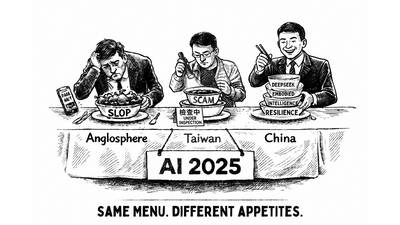
Words of the Year are not just interesting, they are telling. They are language and attitude barometers that measure what a country sees as important. The trending vocabulary around AI last year reveals a stark divergence in what each society notices and responds to the technological shift. For the Anglosphere it’s fatigue. For China it’s ambition. For Taiwan, it’s pragmatic vigilance. In Taiwan’s annual “representative character” vote, “recall” (罷) took the top spot with over 15,000 votes, followed closely by “scam” (詐). While “recall” speaks to the island’s partisan deadlock — a year defined by legislative recall campaigns and a public exhausted
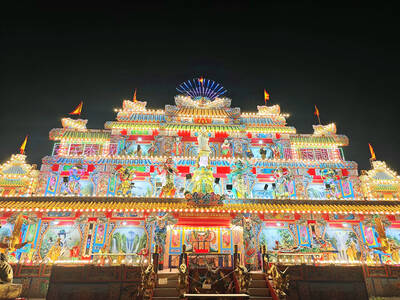
In the 2010s, the Communist Party of China (CCP) began cracking down on Christian churches. Media reports said at the time that various versions of Protestant Christianity were likely the fastest growing religions in the People’s Republic of China (PRC). The crackdown was part of a campaign that in turn was part of a larger movement to bring religion under party control. For the Protestant churches, “the government’s aim has been to force all churches into the state-controlled organization,” according to a 2023 article in Christianity Today. That piece was centered on Wang Yi (王怡), the fiery, charismatic pastor of the